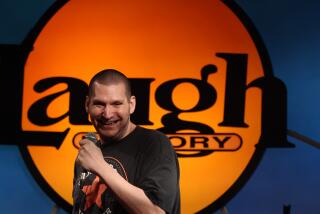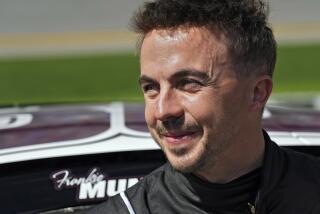A Difficult Year With Progress Hindered, but Not Without Hope
My 7-year-old son, Frankie, wants a puppy. For most parents that would make the choice of his Christmas gift very easy. But Frankie has autism. And that can complicate even the simplest decisions about our family life.
I have occasionally written about Frankie ever since he was first diagnosed with this mysterious neurological disorder five years ago. I try to offer information, and maybe some hope, to readers who face similar challenges.
Frankie continues to make progress, thankfully, but full recovery eludes him. He can’t be cured until a cure for autism is found. And as he grows older, life keeps putting new, more complex, obstacles in his path toward a normal life.
People with autism have their brains wired so that stimuli most of us take for granted--like sound, light and touch--affect them differently. They often have a more difficult time learning academics and engaging in social interaction than nondisabled children. In extreme cases, they withdraw completely from social contact with other people.
Autism is the third most common developmental disability among children after mental retardation and cerebral palsy. One in 500 children is affected, although statistics compiled this year by the California Department of Developmental Services indicate a “dramatic” increase in its incidence here--more than 210% between 1987 and 1998. Yet autism research remains woefully underfunded.
What made 1999 so difficult for Frankie was that his treatment became more complicated in March when we learned that his autism is accompanied by epileptic aphasia--mild seizures in the brain that also affect his ability to communicate. Epileptic aphasia is different from epilepsy, and was only recently discovered thanks to research into the biomedical causes of autism.
Frankie’s diagnosis came after brain specialists conducted a 24-hour EEG on him at the recommendation of his pediatrican, Dr. Ricki Robinson of La Canada, an expert on the treatment of autism and other neurological disorders.
The diagnosis was the classic good news/bad news dilemma. The good news is that brain seizures can be treated with medication. The bad news is that it would take lots of experimentation to find the right medication and dosage for Frankie.
That difficult trial-and-error process continued most of the year and is still not finished. Dr. Robinson tells us that Frankie has unusual brain chemistry, so his reaction to medications is often unpredicatable and, at times, frightening. A mild sedative he was given for the EEG left him in a near-comatose state in an emergency room. Other medications have caused hyperactivity, sleeplessness and even auditory hallucinations.
Recently we finally found a medication that seems to have minimal side effects. But we may still have to find another to help reduce the involuntary motor tics--like handwringing and humming--that Frankie can lapse into when having a seizure.
An especially frustrating result of this experimentation is that it has interfered with Frankie’s progress in school and complicated his ability to blend into a mainstream classroom.
His teachers and classmates at a public school in Glendale are friendly and caring, but there are times when Frankie’s autism and brain seizures leave him in virtual isolation.
Sadly, he is becoming increasingly aware of the fact that he is different from other children. He said recently that he understands how Rudolph the red-nosed reindeer felt when he couldn’t join in reindeer games because “sometimes kids don’t want to play with me.”
Just as troubling is the fact that he has stalled in learning to read. He can sound out words that are spelled phonetically. But he is lost with irregularly spelled words, and can’t make sense of sentences. We are exploring new therapies and learning methods to help him. Last summer he completed Fast ForWord, a computer-based phonics program for children with auditory processing problems like dyslexia. Next on tap is the Lindamood-Bell reading and speech program.
This year Frankie was phased out of the intensive behavior modification therapy he received at the Lovaas Institute for Early Intervention, a clinic founded by a noted UCLA autism researcher, Dr. Ivar Lovaas. I remain a proponent of Lovaas’ once-controversial teaching methods. They gave Frankie a firm foundation for everything he’s been able to learn since.
But even with the measurable progress Frankie has made with the help of Lovaas and Robinson and many other specialists, we must find answers to some hard and painful questions in the coming year. What will help him read? What could get him to initiate more play with other children? Will he need new medications, not just to calm motor tics but to better control his severe allergies, which can also set off autistic behavior when they flare up.
Then amid these concerns, just a few weeks ago, came the question of whether we should get Frankie a puppy.
He’s always been curious about animals, and we are fortunate to have kind neighbors with friendly and approachable dogs--a golden retreiver named Brandy and a pug named Milo.
If Frankie didn’t have autism or severe allergies, he’d have his puppy in a minute. But like so many things other kids take for granted--a slice of pizza (Frankie’s allergic to wheat) or an ice cream (and dairy products)--we must be careful and do some research first.
Frankie’s allergist has advised against keeping a dog in our house. So the answer may be a pre-trained dog for the backyard, perhaps one that didn’t make the cut as a guide dog for the blind. I’m exploring that option now.
But even if everything works out and we find a calm, patient pet dog for Frankie, there will be a lingering sadness in my heart because I couldn’t get my son the puppy he wrote to Santa about.
Maybe someday. Yet another hopeful dream to sustain us through another year with Frankie.
Frank del Olmo is associate editor of The Times.






